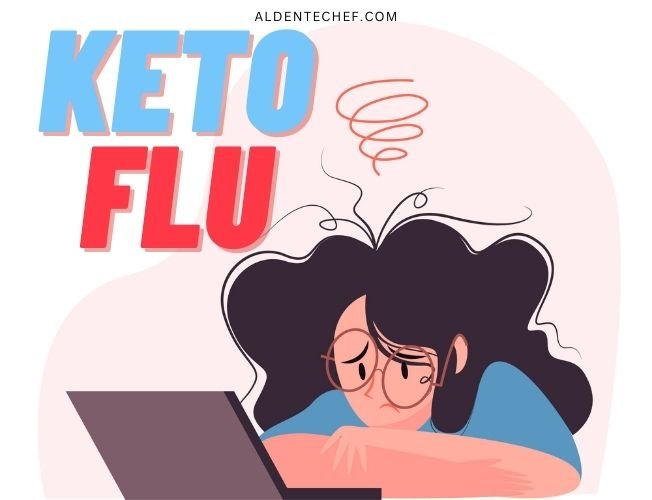We can say that keto flu is a temporary side effect of the ketogenic diet. The ketogenic diet is a low-carb, high-fat eating plan. This diet allows the body to use fats as an energy source. However, when the body restricts its carbohydrate intake and enters ketosis, some people experience a condition called “keto flu”. It is one of the side effects of the ketogenic diet.
For detailed information on topics such as what is a ketogenic diet, how its mechanism works, who can do keto, etc. you can take a look at my article titled “What is a Ketogenic Diet : The Ultimate Guide to Keto“.
Keto flu refers to a set of symptoms that some people experience when they first start the ketogenic diet. These symptoms are usually temporary. They may occur in the early stages of transitioning to a low-carb, high-fat diet.
The body traditionally uses carbs as an energy source. In the ketogenic diet it uses fats as an energy source by producing molecules called ketone bodies. During this transition period, the body has to cope with some changes.
The term “keto flu” is a bit of a misnomer, as it’s not a true disease but rather a collection of side effects associated with the body adapting to changes in macronutrient intake.
There is no rule that everyone will have the symptoms I will talk about. The majority of people go into ketosis without experiencing keto flu symptoms.

What are the symptoms?
The symptoms you may experience, especially in the first week after starting the diet, vary for everyone. However, the following symptoms are the most common:

- Headache: Keto flu can start with a headache and can be severe. This is caused by changes in fluid and electrolyte balance in the early stages of the keto diet.
- Dizziness: It’s a common side effect of keto. Because an extremely low-carb diet drastically reduces your blood sugar levels. Changes in electrolyte levels, especially sodium, can contribute to feelings of dizziness.
- Difficulty concentrating: Some people may experience difficulty focusing or “brain fog” during the early stages of the ketogenic diet.
- Fatigue and weakness: As the body starts to use fats as an energy source, energy levels decrease and the person feels tired and weak. Many people feel tired and lack energy in the first days of the ketogenic diet.
- Nausea: Some people experience feelings of nausea at the beginning of the ketogenic diet. This is caused by the body’s transition into ketosis. It’s normal to feel nauseated until your body gets used to it. Some people may experience stomach upset. This may be a result of the body adapting to higher fat intake.


- Appetite changes: Appetite changes occur during keto flu. Some people report a decrease in their appetite, while others report an increase.
- Sleep problems: You may experience sleep problems at the beginning of the ketogenic diet. We can associate this situation with the change in the body’s energy source.
- Muscle cramps: Changes in electrolyte balance, especially low potassium and magnesium levels, lead to muscle cramps. I recommend you to consume mineral water every other day.
- Irritability and mood swings: Adjusting to a new diet affects your mood. Some people experience irritability or mood swings.
- Itching (Keto rash): A red, itchy rash that can look like a web. It is generally seen on the neck, chest and back. This occurs because the liver detoxes during the diet. This itching goes away on its own within a few days or weeks. If it doesn’t go away, I recommend you stop the diet.

Ways to Deal with Keto Flu
Keto flu symptoms, while uncomfortable, are usually temporary. They disappear within a few days or weeks. Here are some suggestions for dealing with these symptoms:
- Increasing water consumption: It is important to drink enough water to maintain the electrolyte balance in the body.
- Electrolyte supplements: You can take electrolyte supplements to relieve keto flu symptoms. It is important to check the levels of electrolytes such as potassium, sodium and magnesium. Increasing your salt consumption, especially in the beginning, will help you achieve this balance. Choosing rock salt or sea salt will support your mineral intake.
- Getting enough sleep: It is normal for sleep patterns to be affected as the body’s energy source changes. Getting enough sleep relieves symptoms of keto flu.
- Adequate protein intake: Since the ketogenic diet limits protein intake, it is important to get enough protein. Because protein helps maintain muscle mass. But you have to make your decision. Neither more nor less.
- Starting slowly: Starting the ketogenic diet slowly and gradually reducing carbohydrate intake relieves symptoms of keto flu. If you adapt to the diet slowly by reducing your carbohydrate intake, you can enter ketosis without experiencing keto flu.
To see what foods you can consume on the ketogenic diet, read the article called “Keto Friendly Foods“. There is a sample diet list, too.
Ketogenic diet is effective in losing weight, increasing energy levels and improving some health conditions. However, it is also important to consider side effects such as keto flu. If keto flu symptoms persist for a long time, you should consult a healthcare professional.
Remember that not everyone will experience these symptoms. The severity and duration also may vary from person to person. Proper hydration and electrolyte intake help relieve some of these symptoms. To minimize the risk of keto flu, it is necessary to stay well hydrated, ensure adequate electrolyte (sodium, potassium and magnesium) intake, and transition to a ketogenic diet gradually rather than making sudden changes. If symptoms persist or are severe, you should consult a healthcare professional.

